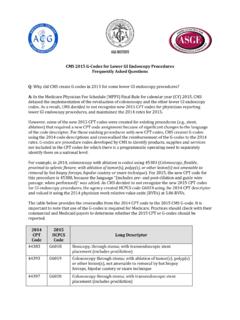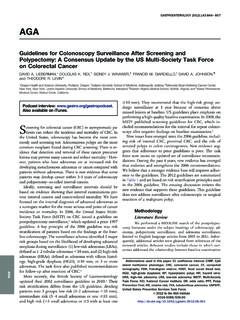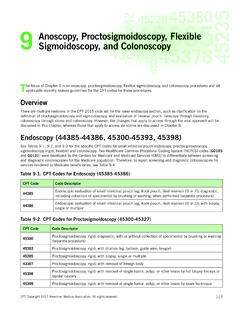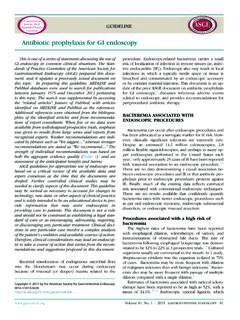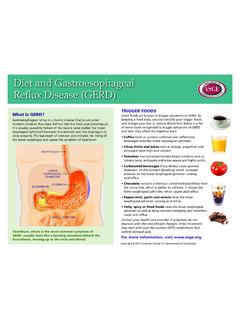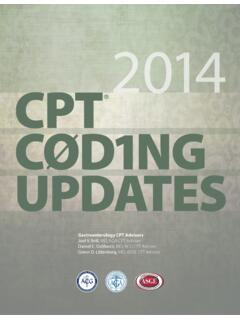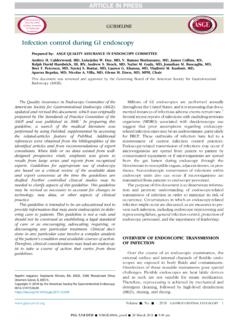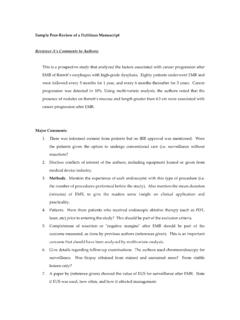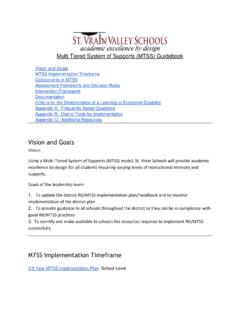Transcription of The management of antithrombotic agents for patients ...
1 GUIDELINEThe management of antithrombotic agents for patientsundergoing GI endoscopyPrepared by: ASGE STANDARDS OF PRACTICE COMMITTEER uben D. Acosta, MD, Neena S. Abraham, MD, MSCE, FASGE (invited content expert, ad-hoc member),Vinay Chandrasekhara, MD, Krishnavel V. Chathadi, MD, Dayna S. Early, MD, FASGE,Mohamad A. Eloubeidi, MD, MHS, FASGE, John A. Evans, MD, Ashley L. Faulx, MD, FASGE,Deborah A. Fisher, MD, MHS, FASGE, Lisa Fonkalsrud, BSN, RN, CGRN, Joo Ha Hwang, MD, PhD, FASGE,Mouen A. Khashab, MD, Jenifer R. Lightdale, MD, MPH, FASGE, V. Raman Muthusamy, MD, FASGE,Shabana F. Pasha, MD, John R. Saltzman, MD, FASGE, Aasma Shaukat, MD, MPH, FASGE,Amandeep K. Shergill, MD, Amy Wang, MD, Brooks D. Cash, MD, FASGE, previous Committee Chair,John M. DeWitt, MD, FASGE, ChairThis document was reviewed and approved by the Governing Board of the American Society for is one of a series of statements discussing the use ofGI endoscopy in common clinical situations.
2 The Stan-dards of Practice Committee of the American Society forGastrointestinal Endoscopy (ASGE) prepared this text. Inpreparing this guideline, a search of the medical litera-ture was performed using PubMed and the CochraneDatabase, with dates of search from August 1966 toDecember 2014. Additional references were obtainedfrom the bibliographies of the identified articles andfrom recommendations of expert consultants. Whenlimited or no data exist from well-designed prospectivetrials, emphasis is given to results from large series andreports from recognized experts. Guidelines for appro-priate use of endoscopy are based on a critical reviewof the available data and expert consensus at the timethe guidelines are drafted. Further controlled clinicalstudies may be needed to clarify aspects of this guideline may be revised as necessary to account forchanges in technology, new data, or other aspects of clin-ical practice.
3 The recommendations were based on re-viewed studies and were graded on the strength of thesupporting evidence (Table 1).1 This guideline is intended to be an educational deviceto provide information that may assist endoscopists inproviding care to patients . This guideline is not a ruleand should not be construed as establishing a legal stan-dard of care or as encouraging, advocating, requiring,or discouraging any particular treatment. Clinical deci-sions in any particular case involve a complex analysisof the patient s condition and available courses of , clinical considerations may lead an endoscop-ist to take a course of action that varies from therapy is used to reduce the risk ofthromboembolic events in patients with conditions such asatrialfibrillation (AF), acute coronary syndrome (ACS),deep vein thrombosis (DVT), hypercoagulable states, andendoprostheses.
4 Antithrombotics include medications classi-fied as anticoagulants or antiplatelet agents ( apas ). Anticoag-ulants prevent the clotting of blood by interfering with thenative clotting cascade and include the following 4 drugclasses: vitamin K antagonists (eg, warfarin), heparin deriva-tives (eg, unfractionated [UFH] and low molecular weight[LMWH], fondaparinux [Arixtra, GlaxoSmithKline, ResearchTriangle Park, NC, USA]), direct factor Xa inhibitors (eg, ri-varoxaban [Xarelto, Janssen Pharmaceuticals, Inc, Raritan,NJ, USA], apixaban [Eliquis, Bristol-Myers Squibb Company,Princeton, NJ, USA], edoxaban [Savaysa, Daiichi SankyoCo, LTD, Tokyo, Japan]), and direct thrombin inhibitors(eg, dabigatran [Pradaxa, Boehringer Ingelheim Pharmaceu-ticals Inc, Ridgefield, Conn, USA], hirudins, argatraban[Acova, Abbott Laboratories, North Chicago, Ill, USA]). apas decrease platelet aggregation, thus preventingthrombus formation.
5 apas include the thienopyridines (eg,clopidogrel, [Plavix, Bristol-Myers Squibb/SanofiPharmaceu-ticals Partnership, Bridgewater, NJ, USA], prasugrel [Effient,Eli Lilly and Company, Indianapolis, Ind, USA], ticlopidine[Ticlid, Roche Pharmaceuticals, Nutley, NJ, USA], and ticagre-lor [Brilinta, AstraZeneca, Wilmington, Del, USA]), theprotease-activated receptor-1(PAR-1) inhibitor vorapaxar(Zontivity, Merck Sharp & Dohme Corp, Whitehouse Station,NJ, USA), glycoprotein IIb/IIIa receptor inhibitors (GPIIb/IIIainhibitors) (eg, abciximab [ReoPro, Eli Lilly and Company, In-dianapolis, Ind, USA], eptifibatide [Integrilin, Merck Sharp &Dohme Corp, Whitehouse Station, NJ, USA], and tirofiban[Aggrastat, Medicure Pharma, Inc, Somerset, NJ, USA]),Copyright 2016 by the American Society for Gastrointestinal Endoscopy0016-5107/$ 83, No. 1 : 2016 GASTROINTESTINAL ENDOSCOPY3aspirin (acetylsalicylic acid [ASA]), and nonsteroidal anti-inflammatory drugs.
6 The duration of action and reversalroutes for the antithrombotic drug classes are described inTable events of antithrombotic therapy include GIbleeding,2,3and their use increases the risk of hemorrhageafter some endoscopic patients takingthese medications who require endoscopy, one shouldconsider the following important factors: (1) the urgencyof the procedure, (2) the bleeding risk of the procedure,(3) the effect of the antithrombotic drug(s) on the bleedingrisk, and (4) the risk of a thromboembolic event relatedto periprocedural interruption of antithrombotic RISKSC ommon endoscopic procedures vary in their potentialto induce bleeding, and these have been outlined in otherTABLE 1. System for rating the quality of evidence for guidelinesQuality of evidenceDefinitionSymbolHigh qualityFurther research is very unlikely to change our confidence in the estimate of qualityFurther research is likely to have an important impact on our confidence in the estimate ofeffect and may change the qualityFurther research is very likely to have an important impact on our confidence in the estimate ofeffect and is likely to change the low qualityAny estimate of effect is very from Guyatt et 2.
7 antithrombotic drugs: duration of action and approach to reversal when indicatedDrug classSpecific agent(s)Duration of actionApproach to reversal based on procedural urgencyElectiveUrgentAPAsAspirin7-10 daysNAHold, can give plateletsNSAIDsVariesNAHoldDipyridamole (Persantine)2-3 daysHoldHoldCilostazol (Pletal, Otsuka PharmaceuticalCo., Ltd., Tokushima, Japan)2 daysHoldHoldThienopyridines: clopidrogrel (Plavix)prasugrel (Effient) ticlodipine (Ticlid)ticagrelor (Brilinta)5-7 days: clopidogrel, 3-5days: ticagrelor5-7 days: prasugrel10-14 days98: ticlopidineHoldHoldGPIIb/IIIa inhibitors: tirofiban (Aggrastat)abciximab (ReoPro)eptifibatide (Integrilin)tirofiban: 1-2 secondsabciximab: 24 hourseptifibitide: 4 hoursNAHoldHD: tirofibanPAR-1 inhibitor: vorapaxar (Zontivity)5-13 daysHoldHoldAnticoagulantsWarfarin (Coumadin)5 daysHoldVitamin K, PCCUFHIV 2-6 hoursSQ 12-24 hoursHoldProtamine sulfate*(partial)LMWH:enoxaparin (Lovenox)dalteparin (Fragmin, Pfizer Inc,New York, NY, USA)24 hoursHoldProtamine sulfate, consider rVIIaFondaparinux (Arixtra)36-48 hoursProtamine sulfate, consider rVIIaDirect factor Xa Inhibitor.
8 Rivaroxaban(Xarelto) apixaban (Eliquis)edoxaban (Savaysa)SeeTables 7 and 8 HoldCharcoal (if last intake within 2-3 hours);nonactivated PCC or activated PCCD irect thrombin inhibitor, oral: dabigatran(Pradaxa)IV: Desirudin (Iprivask, AventisPharmaceuticals Inc.,Bridgewater, NJ, USA)SeeTable 9 HoldCharcoal (if last intake within 2-3 hours);nonactivated PCC or activated PCC; HDNSAIDs,Nonsteroidal anti-inflammatory drugs;NA, not applicable;HD, hemodialysis;PCC, prothrombin complex concentrate;rVIIa, recombinant factor VIIa.*Caution: Can cause severe hypotension and of antithrombotic agents for patients undergoing GI endoscopy4 GASTROINTESTINAL ENDOSCOPYV olume 83, No. 1 : guidelines (Table 3).8 Studies on postproceduralbleeding risks have been conducted in patients who are noton complex antithrombotic regimens and thus may notaccurately reflect the bleeding risk of patients using newerantithrombotic therapies.
9 Traditionally, low-risk procedureshave included diagnostic EGD, colonoscopy, ERCP withoutsphincterotomy, biliary stent placement, and push orballoon-assisted enteroscopy. Mucosal biopsy sampling per-formed as part of these procedures confers a low risk of GIbleeding. Similarly, EUS without FNA, capsule endoscopy,and argon plasma coagulation8are low risk. Nonachalasiaesophageal dilation has been associated with a low risk ofbleeding in large series9,10,11; however, the safety of dilationwhile on anticoagulants is unknown, and the potential foran inaccessible site of bleeding argues for caution in thissetting. High-risk endoscopic procedures are associated witha potential for bleeding that requires an intervention, such ashospitalization, transfusion, endoscopic treatment, or high-risk procedures include polypectomy,13,14therapeutic balloon-assisted enteroscopy (other than argonplasma coagulation),15,16endoscopic sphincterotomy,17 EUSwith FNA, percutaneous endoscopic gastrostomy,18-20percuta-neous endoscopic jejunostomy,21tumor ablation(esophagus, stomach, colon, and rectum),22endoscopicsubmucosal dissection,23 EMR,24pneumatic balloon dilationfor achalasia,25treatment of varices,26ampullary resection,per-oral endoscopic myotomy,27cystoenterostomy,28andendoscop ic therapy of Zenker s risk ofbleeding after polypectomy ranges from.
10 3% to 10% anddepends on a number of factors, including the polyp size,location, morphology (nonpolypoid, sessile, pedunculated),resection technique (cold or hot forceps, cold snare, orsnare cautery), and type of cautery is controversy with regard to whether enteralstent placement is high or low risk. One retrospective re-view of 85 patients with esophageal stents described ableeding risk as high as , subsequentprospective multicenter studies as well as systematicreviews have described bleeding rates in the range to 1% in a variety of GI ,32 CONDITION RISKSThe probability of a thromboembolic event related to thetemporary interruption of antithrombotic therapy for anendoscopic procedure depends on the indication forTABLE 3. Procedure risk for bleeding (overall)Higher-risk proceduresLow-risk proceduresPolypectomyDiagnostic (EGD, colonoscopy, flexible sigmoidoscopy) including mucosal biopsyBiliary or pancreatic sphincterotomyERCP with stent (biliary or pancreatic) placement or papillary balloon dilation without sphincterotomyTreatment of varicesPEG placement*Push enteroscopy and diagnostic balloon-assisted enteroscopyTherapeutic balloon-assisted enteroscopyCapsule endoscopyEUS with FNAyEnteral stent deployment (Controversial)Endoscopic hemostasisEUS without FNAT umor ablationArgon plasma coagulationCystgastrostomyBarrett s ablationAmpullary resectionEMRE ndoscopic submucosal dissectionPneumatic or bougie dilationPEJPEJ, Percutaneous endoscopic jejunostomy.
